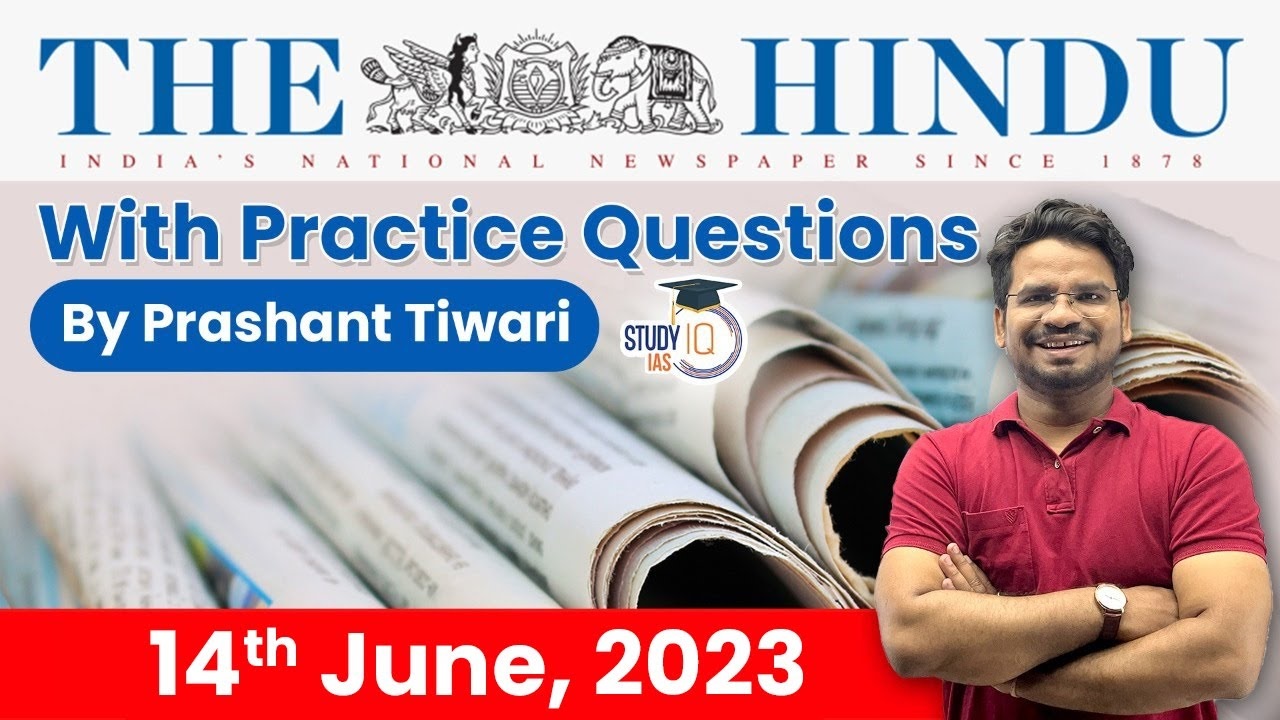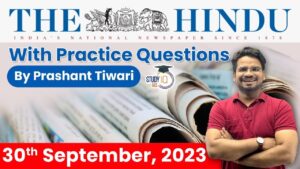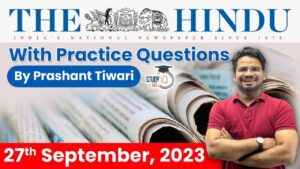The Hindu Newspaper Analysis for UPSC

The Hindu Newspaper Analysis 13 June 2023
Law Related to Blocking of Internet Services/Content:
- Information Technology Act, 2000:
- In India, the Information Technology (IT) Act, 2000, as amended from time to time, governs all activities related to the use of computer resources.
- It covers all ‘intermediaries’ who play a role in the use of computer resources and electronic records.
- The role of the intermediaries has been spelt out in separate rules framed for the purpose in 2011- The Information Technology (Intermediaries Guidelines) Rules, 2011.
The Hindu Editorial Today
- Section 69 of the IT Act:
- It confers on the Central and State governments the power to issue directions “to intercept, monitor or decrypt any information generated, transmitted, received or stored in any computer resource”.
- The grounds on which these powers may be exercised are:
- In the interest of the sovereignty or integrity of India, defence of India, the security of the state.
- Friendly relations with foreign states.
- Public order, or for preventing incitement to the commission of any cognizable offence relating to these.
- For investigating any offence.

- The ethnic Indian community, including the Sikhs, plays an important role in Canada’s public life. There are currently some ethnic Indians in Prime Minister Justin Trudeau’s
- Indian diplomats have the obligation to highlight the damage caused to bilateral ties when Canadian politicians support separatism in India.

- Historical Background of Section 124A (sedition) of the Indian Penal Code:
- Sedition laws were enacted in 17th century England when lawmakers believed that only good opinions of the government should survive, as bad opinions were detrimental to the government and monarchy.
- The law was originally drafted in 1837 by Thomas Macaulay, the British historian-politician, but was inexplicably omitted when the Indian Penal Code (IPC) was enacted in 1860.
- Section 124A was inserted in 1870 by an amendment introduced by Sir James Stephen when it felt the need for a specific section to deal with the offence.
- Today the Sedition is a crime under Section 124A of the Indian Penal Code (IPC).
- Colonial administrators used sedition to lock up people who criticized the British policies.
- 124A – It defines sedition as an offence committed when “any person by words, either spoken or written, or by signs, or by visible representation, or otherwise, brings or attempts to bring into hatred or contempt, or excites or attempts to excite disaffection towards the government established by law in India”.
- Disaffection includes disloyalty and all feelings of enmity. However, comments without exciting or attempting to excite hatred, contempt or disaffection, will not constitute an offence under this section.
- Supreme Court in Kedar Nath Singh vs State of Bihar case 1962, limited application of sedition to “acts involving intention or tendency to create disorder, or disturbance of law and order, or incitement to violence”.

- Prevalence of non-communicable diseases was much higher in urban areas.
- The results of an Indian Council of Medical Research–India Diabetes (ICMR-INDIAB) study published recently in The Lancet show concerning levels of diabetes, hypertension, abdominal obesity and hypertriglyceridemia in India. More importantly, such high levels of disease prevalence were observed across the rural and urban regions of many States.
- It must be noted that the burden of the above-mentioned non- communicable diseases and adverse health conditions is not equally high across all States.
- Non-Communicable Diseases?
- About:
- NCDs, also known as chronic diseases, tend to be of long duration and are the result of a combination of genetic, physiological, environmental and behavioural factors.
- The main types of NCD are cardiovascular diseases (such as heart attacks and stroke), cancers, chronic respiratory diseases (such as chronic obstructive pulmonary disease and asthma) and
- Causes:
- Tobacco use, unhealthy diet, harmful use of alcohol, physical inactivity and air pollution are the main risk factors contributing to these conditions.

- Defence Minister says the moral legitimacy of the United Nations is undermined when India, the most populous nation, is not a permanent member of the UN Security Council; he stresses that the global organisation must reflect current realities.
- India has been one of the top troop contributing nations to UN peacekeeping operations.
- The Security Council was established by the UN Charter in 1945.
- Its primary responsibility is to work to maintain international peace and security.
- The council is headquartered at NewYork.
- Members:
- The council has 15 members: the five permanent members and ten non-permanent members elected for two-year terms.
- The five permanent members are the United States, the Russian Federation, France, China and the United Kingdom.
- India, for the eighth time, has entered the UNSC as a non- permanent member last year (2021) and will stay on the council for two years i.e 2021-22.
- Each year, the General Assembly elects five non-permanent members (out of ten in total) for a two-year term. The ten non- permanent seats are distributed on a regional basis.
- The council’s presidency is a capacity that rotates every month among its 15 members.

- About the U.S.-India initiative on Critical and Emerging Technology (iCET):
- It was launched by the US President and Indian Prime Minister on the sidelines of the Quad summit on May 2022.
- Goal: To elevate and expand Indo-U.S. strategic technology partnership and defense industrial cooperation between the governments, businesses, and academic institutions of the two countries.
- The initiative will be spearheaded by the National Security Council Secretariat in India and the US National Security Council.
- The initiative would help forge links between the government, academia, and industry in areas such as AI, quantum computing, 5G/6G, biotech, space, and
- Under iCET, the two sides have identified six focus areas of co-development and co-production:
- strengthening innovation ecosystems;
- defense innovation and technology cooperation;
- resilient semiconductor supply chains;
- space;
- STEM (science, technology, engineering, and math) talent;
- next-generation telecom;

- The ships launched were Anjadip, the third Anti-Submarine Shallow Water Craft (ASWSWC), and Sanshodhak, the fourth Survey Vessel Large (SVL).
- The ship has been named Anjadip to signify the strategic maritime importance accorded to the island of Anjadip, located off Karwar.



 The Hindu Newspaper Analysis 6 October 2...
The Hindu Newspaper Analysis 6 October 2...
 The Hindu Newspaper Analysis 30 Septembe...
The Hindu Newspaper Analysis 30 Septembe...
 The Hindu Newspaper Analysis 27 Septembe...
The Hindu Newspaper Analysis 27 Septembe...





















